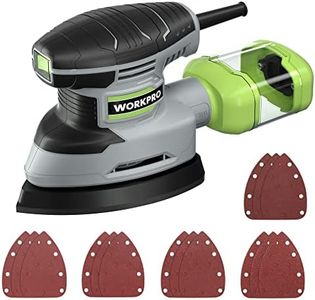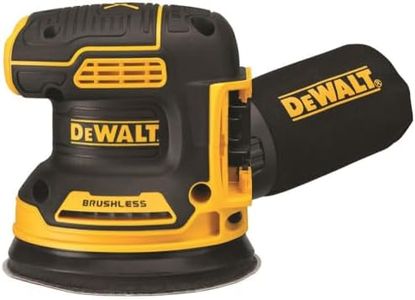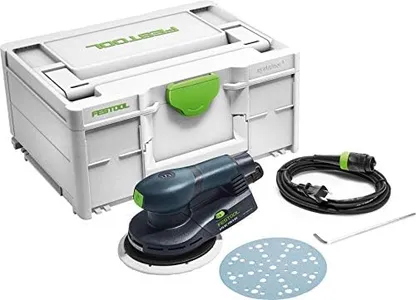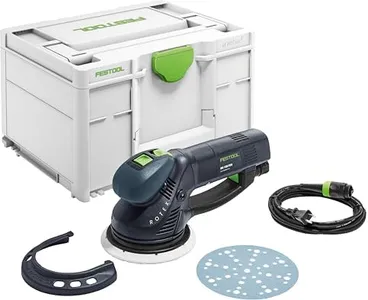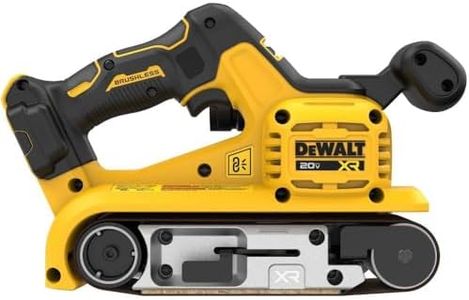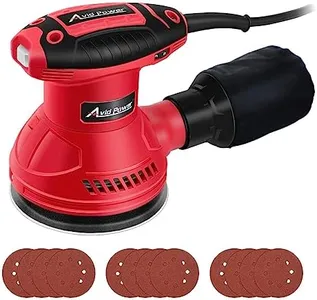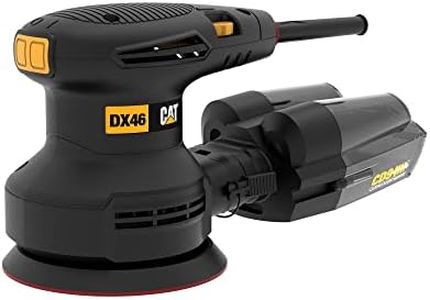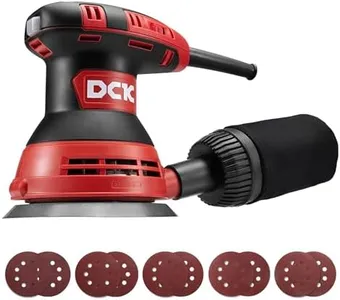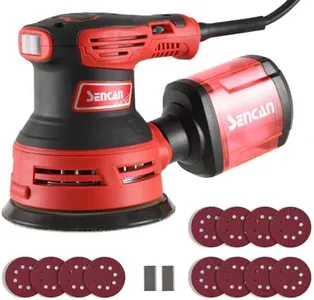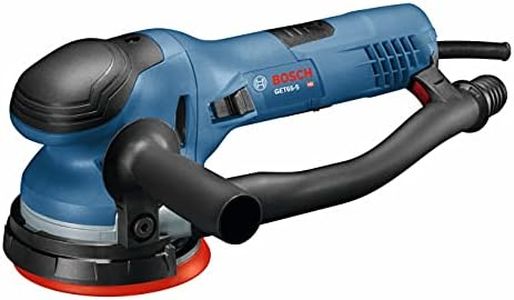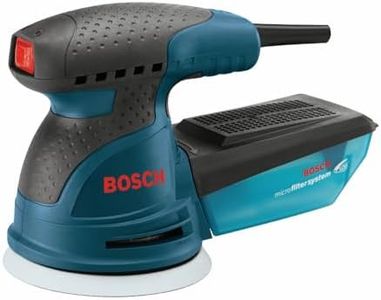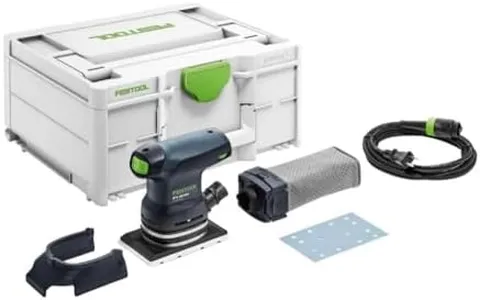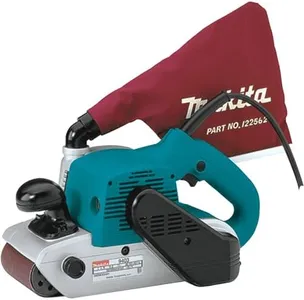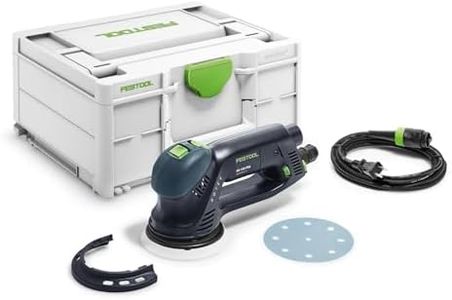10 Best Handheld Sanders 2025 in the United States
Our technology thoroughly searches through the online shopping world, reviewing hundreds of sites. We then process and analyze this information, updating in real-time to bring you the latest top-rated products. This way, you always get the best and most current options available.

Our Top Picks
Winner
DEWALT 20V MAX Orbital Sander, Tool Only (DCW210B)
Most important from
13196 reviews
The DEWALT 20V MAX Orbital Sander is a cordless, battery-powered tool designed for users who want mobility without being tied to a power outlet. It features a brushless motor, which runs efficiently and provides good runtime on a single battery charge. The variable speed control, ranging from 8,000 to 12,000 orbits per minute (OPM), allows adjustment of the sanding speed depending on the project, offering versatility for different materials and finishes.
Its 5-inch sanding pad with an 8-hole hook-and-loop system makes changing sandpaper quick and easy, saving time. The low-profile design helps users get closer to the work surface for more precise sanding, and the rubberized grip ensures comfortable handling over extended periods. Dust management is well thought out; it comes with a one-handed locking dust bag and a dust port that connects easily to DEWALT's vacuum systems, helping maintain a cleaner workspace.
On the downside, the sander is sold as a tool-only model, so batteries and charger must be purchased separately if not already owned. While the dust bag is convenient, it may fill up quickly during heavy use compared to a full vacuum system. Weighing just over 2 pounds, the sander is light enough for most users but might feel slightly bulky to some. It suits DIYers and professionals who need a reliable cordless orbital sander for fine sanding jobs with good dust control. Though not the cheapest option, its build quality, power efficiency, and ergonomic features make it a solid choice for those invested in the DEWALT 20V battery platform.
Most important from
13196 reviews
Festool 576339 6-Inch Random Orbital Sander ETS EC150/5 EQ-Plus
Most important from
137 reviews
The Festool 576339 6-Inch Random Orbital Sander ETS EC150/5 EQ-Plus is a corded electric handheld sander that caters well to both coarse and intermediate sanding needs. This sander boasts a robust motor power, operating at 4.5 amps, which ensures efficient material removal with its 5 mm sanding stroke. One of its standout features is the stepless speed pre-selection, allowing users to maintain a constant speed even under load, which is essential for achieving consistent results on various surfaces.
The inclusion of EC technology and a sanding pad brake with a carbide tip contributes to the tool's longevity, making it a durable option for frequent use. Ergonomically, the Festool sander is designed to minimize user fatigue, weighing only 2.5 lbs (1.2 kg) and incorporating a Vibration Control System for smoother operation. This makes it comfortable to use over extended periods, ideal for detailed and precision work.
The pad, sized at 6 inches and compatible with the Multi-Jetstream 2 system, ensures effective dust collection, promoting a cleaner work environment. However, the sander's compact design might limit its usage for larger surface areas, and its reliance on a corded power source could restrict mobility compared to cordless alternatives. Additionally, the product dimensions and weight of the entire setup, including the Systainer3 case, may be a bit bulky for some users. Despite these minor drawbacks, the Festool 576339 is supported by a 3-year manufacturer warranty, making it a reliable choice for those prioritizing precision and comfort in their sanding tasks.
Most important from
137 reviews
Festool 576028 6-Inch Random Orbital Multi-Mode Sander ROTEX RO 150 FEQ-Plus
Most important from
217 reviews
The Festool 576028 6-Inch Random Orbital Multi-Mode Sander ROTEX RO 150 FEQ-Plus is a powerful, corded electric sander designed for both professional and DIY use. One of its standout features is the FastFix sanding pad system, which allows you to change pads quickly and easily without needing any tools. This sander offers two motion modes: eccentric motion for smooth, scratch-free finishes and rotary motion for fast material removal. This dual functionality makes it versatile for various sanding tasks.
Its ergonomic design ensures comfortable handling, even during extended use, and the Festool Protector allows you to sand right up to the edge without damaging adjacent surfaces. With a 6-inch pad size, it covers a good surface area, making it efficient for larger projects. However, its corded nature means you'll need access to a power outlet, which might limit mobility.
While the sander is highly effective, it is on the pricier side, which might not be ideal for those on a tight budget. The Festool 576028 is a reliable, high-performance sander suitable for detailed finishing and heavy material removal, best suited for users who need a robust and versatile tool for various sanding applications.
Most important from
217 reviews
Buying Guide for the Best Handheld Sanders
Choosing the right handheld sander can make a significant difference in the quality and efficiency of your woodworking or DIY projects. Handheld sanders come in various types and sizes, each designed for specific tasks. Understanding the key specifications and how they align with your needs will help you make an informed decision. Here are the essential specs to consider when selecting a handheld sander.FAQ
Most Popular Categories Right Now
